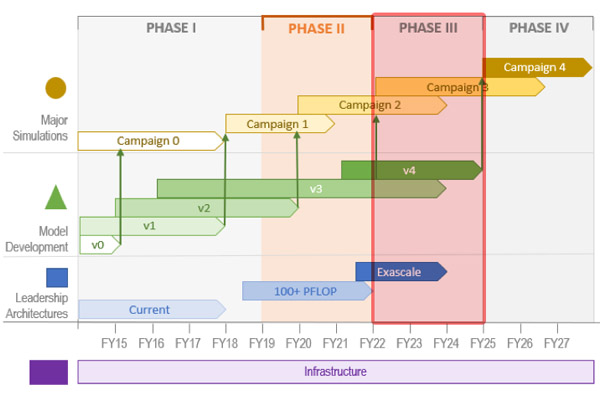E3SM Phase 3 Timeline

The E3SM Project Roadmap, showing the relative sequencing of major simulation campaigns, model version development, and machine deployment addressed in each project phase.
The E3SM project is reaching the end of its phase 2 (second funding) of the (about) 3-year cycle Scientific Focus Area (SFA) funded by the Office of Biological and Environmental Research (BER) within the Department of Energy (DOE). This type of funding is targeted for integrated research programs at all relevant DOE National Laboratories addressing specific Scientific Focus Areas (SFAs) within BER’s science portfolio. SFAs are subject to merit review procedures for research at the DOE Laboratories that are parallel to the processes and procedures for the private sector. In its oversight role BER requires formal annual program management and performance reporting for each National Laboratory SFA and formal triennial scientific and program management review of each SFA.
For a typical 3-year SFA project, at the end of the 3-year cycle, BER issues a letter to the project, inviting it to write a “white paper”, a short proposal for the next funding period, followed by a full proposal and a formal review. The review evaluates accomplishments and the project’s performance from the previous cycle and focuses on the project’s proposal for the next funding period. The review is conducted by an external panel of scientific experts whose competencies complement those of the E3SM project. On average there is a panel of 12-16 reviewers and the review is attended by interested DOE program managers.
The E3SM project started as ACME (Accelerated Climate Modeling for Energy), a 3-year BER SFA project in 2014. At the end of the 3-year SFA cycle, E3SM went through the process described above. The first funding of E3SM (called phase 1 of the project) spanned the years 2014 to 2018 and culminated with the release of version 1 of the E3SM model. While preparing for the phase 2 white paper, the E3SM Executive Committee together with the E3SM Council critically reflected on the project and identified all the areas where there were shortfalls, either in the structure of the project or the execution, and found ways to propose solutions. They also looked forward to what the project needs to succeed with the proposed vision, mission, goals, and deliverables of the next phase. The project underwent a thorough restructuring between phases 1 and 2, focusing on the development to fulfill the simulation campaigns (hence the change from the component-based science groups – Atmosphere, Land, Ocean/Ice, and Coupled – to simulation campaign groups – Water Cycle, Biogeochemical Cycles (BGC), and Cryosphere). The project needed long-term focus areas for development targeting versions 3 and 4 of the model, but at the same time, had to deliver version 2 of the model and its simulation campaign. This is how the Next Generation Development projects were born as more autonomous long-term developments within the project, while focused short-term Core Development was being performed by the Core Groups consisting of three simulation campaign groups (Water Cycle, BGC, and Cryosphere) and two computer engineering groups (Infrastructure and Performance).
The project is now at the end of the second round of funding of the E3SM SFA and the Leadership team consisting of the Executive Committee and the Council has begun a series of four sessions of four-hour-long meetings focused on decisions about all aspects of phase 3 of the project. The project received the white paper request and guidance from BER in the middle of November 2021. The document is expected to identify the research goals, objectives, and approach for the next phase of the project within the context of the project’s updated decadal vision. It should highlight the science plan involving model development with new simulations for phase 3 as well as the management plan. The white paper (25 pages long + bibliography) is due by January 31, 2022, and the full proposal is due by July 29, 2022. The project’s review is expected to occur in mid-October 2022.


